Steemit Crypto Academy Season 2: Week8 | HASHGRAPH TECHNOLOGY, by @ pelon53
Hello everyone welcome to this weeks Steemit Crypto Academy Homework Task. I have gone through this week's lecture by Prof. @pelon53 and i would like to thank you for the well detailed lecture. I will be answering this week's task question below.
Explain in detail the Gossip protocol, used in Hashgraph.
When we talk about Gossip protocol, what comes to mind is very simple, its a communication protocol that is designed in a way that it is a highly secured, efficient and low latency distributed communication system. In other words, it is used by digital devices to propagate information on a peer-to-peer network (P2P). This protocol is usually used by network nodes in the blockchain networks to spread and disclose information faster and reliably between each other. However, communication protocols are applied according to the requirements of each user or networks used dues to the fact that there are variations of this communication protocol.
The Hashgraph make use of this gossip protocol to achieve a consensus on the network data. In other words, The protocol sends the transaction information to the network nodes and then come to a consensus on the transactions. However, the nodes continues to communicate all the data that they have on the transaction randomly to the other nodes, which enables the transaction information to be spread rapidly through out the network. This protocol continue until it gets to a certain point where the information is replicated on all the nodes of the Hashgraph network, this is known as the gossip about gossip protocol. Hence, the nodes can be validated, information is processed and there is a concrete knowledge of the details in the operation at the same time.
This process enables the validation process to be much faster and efficient than in other protocols like PoW or PoS. For example, if there is about 100 destinations of messages sent from the beginning, then each of these destinations replicates the messages to 100 different destinations. Once this continues through the chain, it means that the messages will get to all the other nodes that make up the network in just a few transmission operations. When this transmission occurs together with Hashgraph technology, transactions are been confirmed by the nodes on the network in few second. This also allows up to 10,000 transactions per seconds which is seen as a huge improvement in scalability compared to Bitcoin and other coins.
Explain Tolerance to Byzantine Faults in Hashgraph.
When you talk about Tolerance to Byzantine Faults in Hashgraph, it simply means that there is no small group of member or single member that can actually prevent the community from getting a consensus or even change the consensus when it is reached, hence each member will eventually get to the point where they know definitely they have reached consensus. It is not often guaranteed of the Byzantine agreement on the blockchain because a member might end up not reaching certainty of the agreement that has been achieved. Moreso, the blockchain does not automatically deal with network partition because its non-Byzantine.
It is very important to note that Byzantine Fault Tolerant (BFT) in Hashgraph is used in its original and stronger sense unlike some other consensus algorithms that use it in a weaker sense. In Hashgraph, It enables members know when a consensus is reached and cause attackers to collude.
Byzantine Fault Tolerant is know to have different degrees depending on the assumptions that are made about the network and message transmission. 2/3 of the protocol has been assumed correctly that if messages are sent repeatedly from one node to another, one will eventually get through and then another until they all get through. Asynchronous BFT is the strongest form of BFT and this gives the impression that its can reach consensus even if there is a malicious control over the network or it deletes or slows down messages of their choice.
Make a comparison between Hashgraph Vs Blockchain, for a voting process in your country. Which technology would you choose? Why?
Consensus mechanism
Hashgraph utilizes the virtual voting system to gain its network consensus, it does not require other algorithm as it can preform highly on low-cost with out failure, hence it doesn't need a high computation power or electrical supply.
While Blockchain utilizes various algorithms to reach a consensus depending on the cryptography an coins. Proof-of-Stake, Proof-of-Work, Practical Byzantine Fault Tolerance etc are some of the popular algorithm that the blockchain uses.
Faster transactions.
Hashgraph provides faster transaction speed with the use of the gossip about gossip protocol which requires less information to disseminate when events are taking place. Apparently, it processes up to 500,000 transactions per second.
While Blockchain is slower than Hashgraph, it processes from 100 to 10,000 per seconds. It depends on the implementation of protocols like Hyperledger, blockchain platforms like Corda and more for the speed of transactions.
Open-source vs. Patented
The Blockchain is an open-source DLT platform that allows users to contribute to the building of cryptocurrencies and other tokens. The blockchain is decentralized so users are free to part take in the system.
While Hashgraph is a patented algorithm thats owned by Swirlds. Users does not have direct access so they have to pass through Swirlds which is like a third party to carry out any new entry.
Efficiency
Blockchain use blocks and this makes it difficult for miners to come to a decision of which to work with if they are two of them, hence they have to discard one making the effort of the discarded one wasted.
While Hashgraph does not make use of blocks, it is considered 100% efficient because it does not encounter the block problems. Resources are not wasted or discarded as all the events gossiped to the network are well reserved.
There are many reasons why i would not chose the blockchain technology for a voting process in my country because it is not beneficial for a voting system. This encryption system assumes that there is malicious software in the voter's device. It also assumes that the votes will be completely public because of its transparent nature and someone can easily hack into it to make the votes public. The blockchain network can only handle small voter populations but can not handle the larger amount of information created from the general voter population on the voting system. Cyberhackers can undetectably edit the Ballots submitted online or send a malicious software to the device of voters or even attack the server which can jeopardize the voting process.
However, my country does not make use to the electronic voting process because of the following reasons.
- Internet voting will give attackers the opportunity for them to engage in harmful disruption attacks, with the motive of disabling the system and preventing voters from casting ballots which will lead to undermining voter trust in the election.
- Receiving ballots as encrypted attachments can expose the election system to systemic attacks.
- Expert attackers can get into an eligible voters emails and use fraud ballots to deliver a malicious software that can be used to gain entry into the election system infrastructure.
Explore Inherit Hashgraph link show screenshots.
Inherit Hashgraph is the official distributed consensus platform that is built with the hashgraph consensus algorithm for a fast, fair and secure transaction. Hedera empowers developers by allowing them build an entirely new class of decentralized application. So i will be showing some of the features of this platform.

This is the front page of the platform, once you launch the pag, thats what you see first. On the right top side of the front page, you will see three lines. Click on it and you find some drop-down like below.

This drop down contains:
- Network
- Devs
- Use Cases
- HBAR
- Governance
- About.
So i am going to be taking them one after the other.
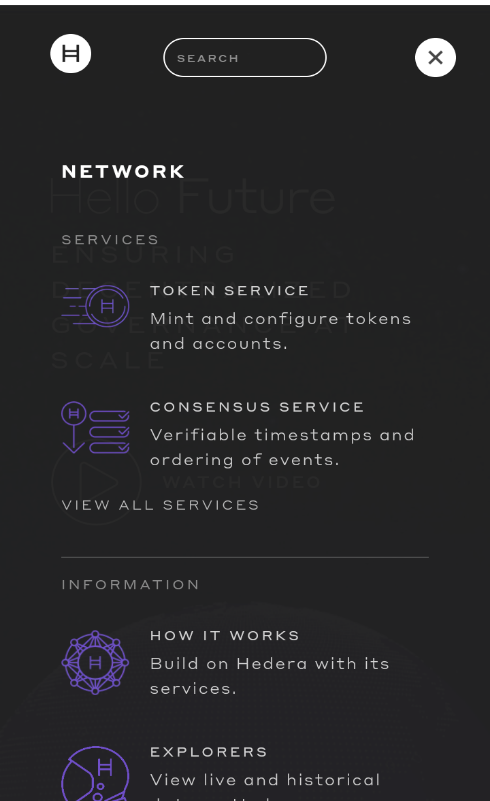
Under the "Network" drop down, you can find
- Services: Which contains token services, consensus services and all services.
- Information: contains how it works, explorers and dashboard.
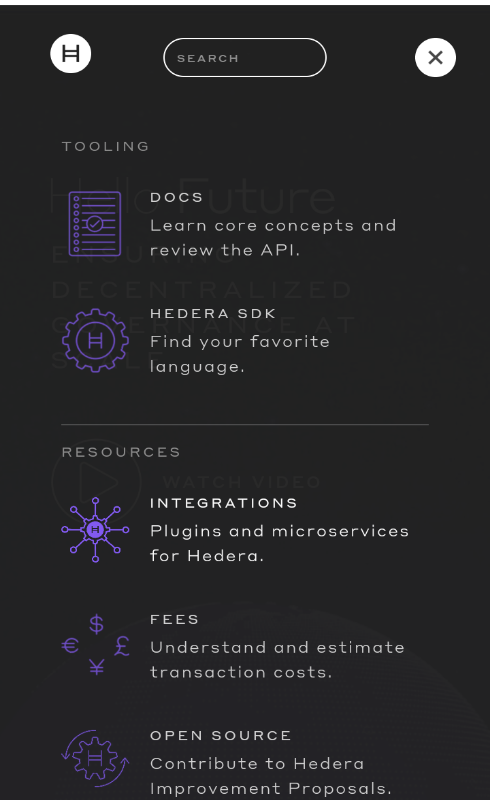
Under "Devs" drop down, you can find:
- Tools: which contains Docs that you can learn the core concept and review of API.
- Hedera SDK: here you can find your favorite languages.
- Resources: Contains integrations, Fees, Open Source and learning center.
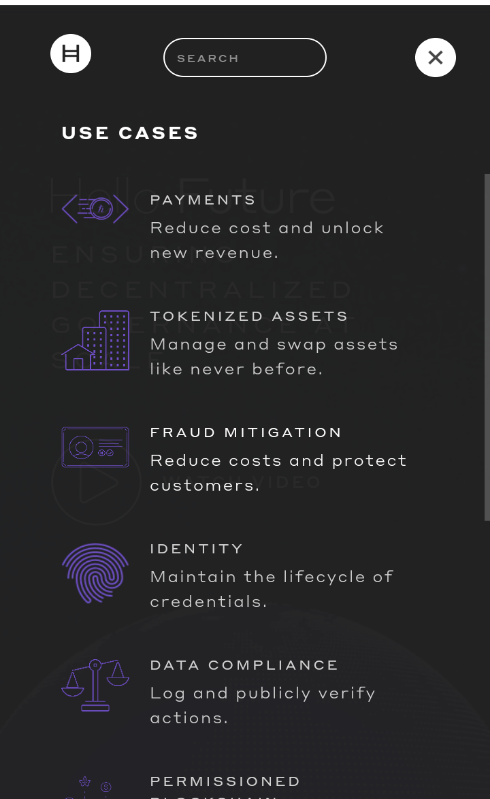
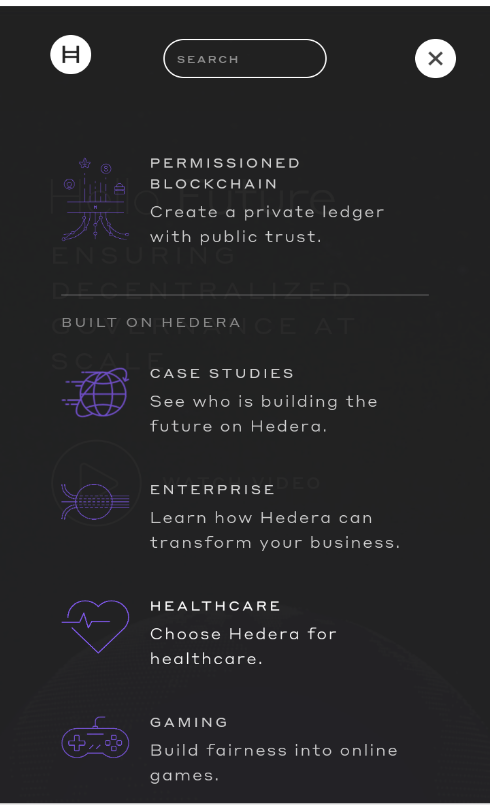
Next
Under "Use Case" you can find:
- Payments, Tokenized assets, Fraud Mitigation, identity, Data Compliances and permitted blockchain.
- Built in Hedera: contains Case Studies, Enterprises, Healthcare, and Gaming.
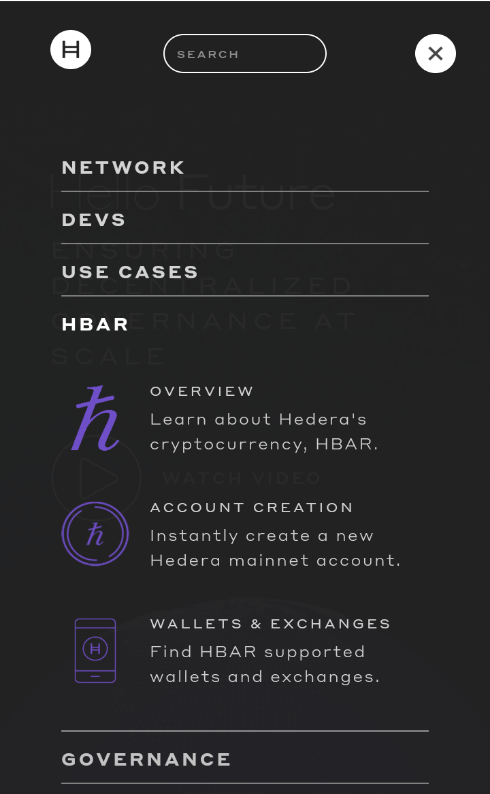
Under "HBAR" icon, you can find:
- Overview where you can learn about the Hedera cryptocurrency HBAR.
- Account Creation where you can instantly create a new Hedera MainNet Account.
- Wallet and Exchange where you can find HBAR supported wallet and exchange.

So once you click on the "Governance" icon it takes you to the above page.
Thank you so much for reading.
.jpeg)
Gracias por participar en Steemit Crypto Academy:
Este protocolo Gossip distribuye y propaga la información en la red, no es el encargado de llegar al consenso. 👇
Pero hasta 1/3 de nodos maliciosos, si es más de 1/3 puede existir problemas.
Espero seguir leyendo tus publicaciones.
Calificación: 5.9